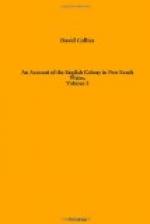The settlers in and about Parramatta had not so much ground in cultivation, and were fewer in number than those of the Hawkesbury district. A widow woman of the name of Daveny, whose husband had been a superintendant of convicts, had fifty acres in wheat, and twenty-three in maize. Among the individuals who had attended to the rearing of stock must be mentioned with the credit which he merits, Edward Elliot, who, having firmly withstood every temptation that was placed in his way to induce him to sell them, had at this time a stock consisting of 116* sheep, derived from one ewe, which had been allowed him by Governor Phillip in December 1792. It, perhaps, may be read with some satisfaction, that George Barrington appeared to have twenty acres of ground in wheat, and to be the possessor of thirteen sheep, fifty-five goats, and two mares. His conduct continued such as it had been from the first; but his health was visibly declining, his unremitted attention to the duties of his office proving too much for an asthmatic habit, which he brought with him from England.
[* Vide Vol I Ch. XXXI p 401, viz: ’One man, a settler at the Eastern Farms, Edward Elliot, had received a ewe sheep from the late Governor Phillip before his departure in the year 1792. He had resisted many temptations to sell it, and at the time this inquiry took place was found possessing a stock of twenty-two sheep, males and females. He had been fortunate in not meeting with any loss, but had not added to his stock by any purchase. This was a proof that industry did not go without its reward in this country. Other instances were found to corroborate this observation.’]
There were nine hundred and three goats, three hundred and thirty-two sheep, and about four hundred hogs, in this district, the settlers of which were one hundred and four in number.
It has been shown, that the cultivated ground in the district of the principal settlement was far less than in either that of the river, or Parramatta. At each of these, the soil was greatly superior, and had therefore been more desired by settlers; it must moreover be observed, that most of the farms in the neighbourhood of Sydney were taken before much knowledge had been obtained of the superior richness of the soil in the interior, over that near the coast. The greatest quantity of ground in cultivation by any individual was thirty-three acres. Their stock of sheep amounted only to thirty-eight, of goats to two hundred and ninety-two; and there were remaining among them about three hundred and sixty hogs. The number of settlers was seventy-one. In this statement, the farms and stock of the officers of the civil and military department, and of some of the free settlers, were not included.




